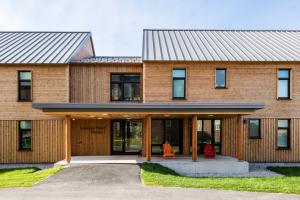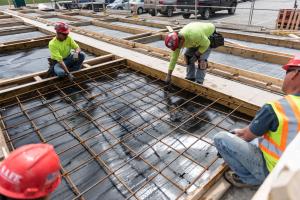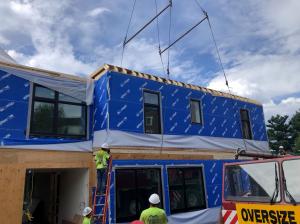At Colby College, the design-build Johnson Pond Houses project delivered a four-building student residence complex just fifteen months from mere project conception. Comprised of pre-fabricated structural units and pre-cast concrete foundation panels, the 40,000 sq. ft. facility houses 200 student beds.
Design
When planning an aggressive project schedule, utilize repetitive design details to ensure quality and efficiency as multiple elements are built simultaneously off-site.
Pre-cast Concrete Foundations
The concrete foundations at Johnson Pond Houses were designed to eliminate on-site formwork and ease transportation to site. Consigli’s Virtual Design and Construction (VDC) team developed 35 concrete panel shop drawings to be repeated for each building. Each panel included every penetration, lifting device, reinforcing detail and finishing requirement, with concealing joints between panels. Foundations Engineer of Record Trillium Engineering reinforced details and accelerated drawing approvals.
To confirm there were no conflicts between the concrete, volumetric modular structural unit models, embeds and site work, each panel type was digitally modeled and clash-detected with the structural unit models. Drain lines, HVAC system louver openings, boiler vents, sprinkler drains and electrical conduits were modeled and sleeved in the panels based on the 3D model of Mechanical, Electrical, Plumbing and Fire Protection (M/E/P/FP) systems.
Volumetric Modular Structural Units

KBS Builders Inc. (KBS) pre-fabricated structural units that allowed in-factory framing, electrical, plumbing and fire protection installation. Consigli and the Kaplan Thompson Architects design team engaged M/E/P/FP design-build subcontractors for weekly coordination meetings to advance the design with KBS. With 18 structural units per building repeated across four houses, coordination and review of KBS shop drawings were required twelve weeks prior to on-site delivery.
The design-build delivery of the four repetitive buildings allowed the team to rapidly adjust design details and apply adjusted concepts from the first building to the last in real time for schedule and quality improvements. The structural units were designed to deliver nearly complete interiors for all spaces except the corridors and pre-cast basements.
Pre-fabrication
Traditional on-site construction limits simultaneous trades on site, due to its inherent sequential nature (first comes site work, then foundation, framing and so on). Pre-fabrication supports faster, higher-quality construction by simultaneously managing multiple trades and delivering materials to site only when installation-ready.
Pre-cast Concrete Foundations

Consigli Self-perform in Pre-casting Yard
With zero flexibility on structural unit delivery, the team had only four working days to set the foundation walls for each building. Consigli turned the parking lot adjacent to the project into a near-site pre-casting yard to construct foundations during sitework, allowing the team to pre-cast and pre-kit the panels on truck beds for just-in-time (JIT) delivery once the site was ready.
From the VDC group’s detailed drawings, Consigli’s self-perform team formed and pre-casted each of the 140 panels. A heated form structure supported rapid pre-cast at ground level, reducing jobsite hazards such as weather-caused slips and potential soil/excavation collapse in the foundation holes. The Consigli carpenters’ pre-casting system formed, reinforced, casted, cured and stripped panels on a five-day cycle.
Volumetric Modular Structural Units
Structural unit pre-fabrication occurred simultaneously with site preparation, foundation and steel fabrication, all of which converged on the date units were delivered to site. Each 18-unit building took 20 working days to pre-fabricate, including the installation of M/E/P systems, insulation, operable windows, an exterior air vapor barrier and a highly insulated exterior wall system to provide a Net Zero Ready structure. The interiors of the bedroom units, bathrooms and common area rooms included the installation of drywall, light fixtures, electrical outlets, flooring and finish paint.
Delivery & Installation
Pre-fabrication reduces on-site labor density, ensures manpower consistency and decreases safety incidents. To reap the benefits of off-site prefabrication against an aggressive project schedule, extensive coordination of trades is essential.
Pre-cast Concrete Foundations
Concrete panels were delivered just-in-time and placed with a crane with structural steel support beams. Consigli’s self-perform installers set the entire foundation wall system in less than three days—from the first panel being set to the start of wood sill plate installation.
Threaded inserts allowed clean picks off the panels’ sides. Embedded cam rotational picks rotated the panels from their flat to vertical positions for installation. Temporary bracing held the panels in place while awaiting structural unit installation, and top embeds were set to lock in the units come time for installation.
Volumetric Modular Structural Units

Structural Unit Installation
Structural units were delivered in two stages per building (left and right side, two-floors high). In typical pre-fabricated structural unit assembly, units fit with no openings to the exterior. Unique to the Johnson Pound Houses, the structural units had openings for corridor connections when set in place. Keeping each building weathertight between setting units and getting the roof tilted required careful, multi-trade coordination.
Consigli reviewed punch list items throughout construction, catching deficiencies when work was first put in place. Every item delivered was immediately quality reviewed, further accelerating the completion of each building by taking early corrective action.
